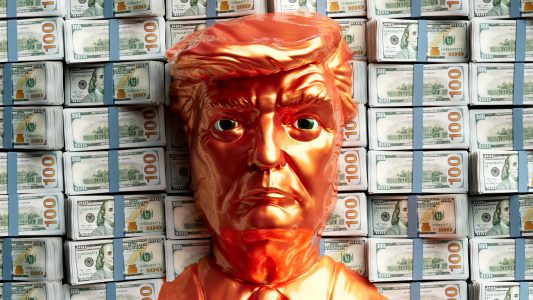Widgetized Section
Go to Admin » Appearance » Widgets » and move Gabfire Widget: Social into that MastheadOverlay zone
How Tariffs May Impact State Budgets: Economic Ripples from Trade Policy
The views expressed are those of the author and do not necessarily reflect the views of ASPA as an organization.
By Thomas Young
April 21, 2025

Tariffs—generally a form of a sales tax on imported goods—capture federal policy preference for boosting domestic industries or negotiating trade deals.
The impacts of tariffs go far beyond federal economic policy. One of the less examined areas of impact is state budgets. Understanding the dynamic impacts is key for policymakers, business managers and civilians.
Direct Effects Through Economic Activity
At the most basic level, tariffs are an attempt to boost domestic production at the cost of, at least in theory, raising the price of imported goods. For consumers, this can mean higher prices on everything from electronics to clothing. For businesses, especially those dependent on foreign inputs – like manufacturers, retailers and construction firms—tariffs can significantly increase operating costs. These cost increases can reduce overall economic activity in a state by dampening consumer spending and slowing business investment if the tariffs fail to lower costs in other ways, such as reducing transportation costs by boosting production in the domestic economy.
Since most state budgets rely on sales taxes, income taxes and corporate taxes, any slowdown in economic activity directly affects tax revenue. A drop in consumer spending means less sales tax collected. But if the overall volume of consumption does not change but prices rise, then states and local governments will see a boost to their sales tax revenue.
Industry-Specific Exposure
The impact of tariffs is not uniform across states. It depends heavily on each state’s economic structure and trade dependencies. For instance, states with strong manufacturing sectors such as Michigan, Ohio and Indiana could face disproportionate effects if tariffs target automotive parts or steel. When these industries face rising input costs or retaliatory tariffs from other countries, they may scale back production or reduce employment, shrinking the tax base for the state. That’s the worst-case scenario. It’s also quite possible that tariffs will boost receipts if production and economic activity shift back to these states.
As is well known, agricultural states are also exposed. In previous tariff disputes, particularly during the U.S.-China trade war, China imposed retaliatory tariffs on soybeans, pork and other crops, harming exports from states like Iowa, Nebraska and North Dakota. The resulting loss for farmers not only trimmed income tax revenue but also led to greater discussion of ways to support the agricultural sector.
Retaliatory Tariffs and Export-Driven Economies
Many states also benefit from exports. When U.S. tariffs trigger retaliation, other countries may impose duties on American goods in return. This tit-for-tat escalation hurts export-dependent industries and the states where they are concentrated.
Take Washington state, where aircraft manufacturing and software exports are major economic drivers. During past trade spats, retaliatory tariffs from Europe and China on Boeing aircraft created uncertainty for the state’s economy. A decline in aerospace exports can lead to layoffs and reduce business tax collections, creating revenue challenges for the state government.
Increased or Decreased Costs for Government Procurement
Tariffs, of course, impact not just the private sector. They also can increase, and potentially decrease, costs for state and local governments that procure materials for infrastructure and public projects. For instance, if tariffs are imposed on steel, aluminum or construction machinery, public works projects— including bridges to schools—become more expensive to complete.
This could mean state governments either have to delay infrastructure projects, reduce their scope or divert funding from other services to make up the difference. Interestingly, this conventional wisdom view is hard to show at an aggregate level. It is also likely that in some cases, tariffs reduce the costs of government through a local production effect. It’s difficult to see this “invisible” impact at the moment, but it could materialize over time through innovative solutions to cost-prohibitive projects through technology or other factors.
Short-Term Windfalls and the Potential for Long-Term Benefits and/or Strains
There can be short-term benefits for states with industries protected by tariffs. For example, U.S. steel and aluminum producers may benefit from reduced foreign competition, leading to local job growth and increased tax revenue. States like Pennsylvania or West Virginia could experience a temporary boost if domestic production ramps up.
Fiscal Policy Flexibility and Risk Management
States have limited control over federal trade policy, but they must prepare for the fiscal impacts that stem from it. Diversifying revenue sources, building robust rainy-day funds, reducing expenditures now and monitoring trade exposure by sector are all ways states can increase their resilience.
Additionally, some states have begun to engage in trade diplomacy directly, establishing offices abroad or signing memoranda of understanding with foreign governments to strengthen economic ties. While these actions can’t override federal tariff policy, they reflect a growing awareness that global trade dynamics are inseparable from state-level economic planning.
Conclusion
Overall, we live in dynamic economic times. It is said by some that there are weeks when decades are made and decades when weeks are made. In terms of the economic picture, now is a consequential time.
Author: Thomas is an economics consultant. He works in or has worked in non-profit think tank economics consulting, for-profit economics consulting, state government, the U.S. Department of Justice, and the National Science Foundation, among others. He did his Ph.D. in business economics.


 (2 votes, average: 4.50 out of 5)
(2 votes, average: 4.50 out of 5)
Follow Us!